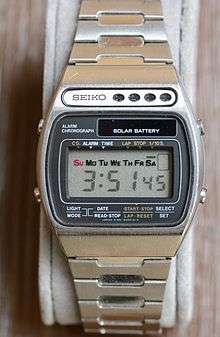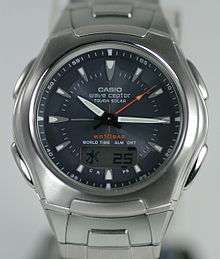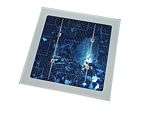Solar-powered watch
A solar-powered watch or light-powered watch is a watch that is powered entirely or partly by a solar cell.

Some of the early solar watches of the 1970s had innovative and unique designs to accommodate the array of photovoltaic solar cells needed to power them (Synchronar, Nepro, Sicura and some models by Cristalonic, Alba, Rhythm, Seiko and Citizen). In the 1990s, Citizen started to sell light-powered watches under the Eco-Drive series name. Since their introduction, photovoltaic devices have greatly improved their efficiency and thereby their capacity. Watchmakers have developed their technology such that solar-powered watches are now a major part of their range of watches. Several other watch manufacturers offer similar watches or are developing such technology. These other watch manufacturers include (amongst others) Junghans, Casio, Seiko, and Orient.[1][2][3][4][5][6]

Typically, sunlight and artificial light are absorbed by a solar panel behind the crystal. The dial is either on a layer above or actually on the solar panel. This solar panel converts the light into electrical energy to power the watch. The watch will usually store energy in a rechargeable cell to power itself during the night or when covered such as a wearer's clothing (e.g., sleeve). Citizen's watches use lithium-ion batteries to store sufficient energy to power the watch for several months/years without light exposure, by allowing the watch to enter a power-saving or hibernation mode during which the seconds hand stops until the watch is re-exposed to light. Not all have a power-save mode, yet will still hold a charge for typically six months, as with uncomplicated (date only) analog versions made by Citizen.
Inexpensive solar-powered watches were first sold in the 1980s and were popular amongst children, often featuring famous fictional characters such as Transformers or G.I. Joe.
References
- Orient Light-Powered Watches (Global Market), Accessed 28 September 2014
- Orient Light-Powered Watches & Movement Manual (Global Market), Accessed 28 September 2014
- List of Orient Watch Manual & Movement (Global Market), Accessed 28 September 2014
- Orient Light-Powered Watches (Japan Domestic Market) Archived 2014-10-08 at the Wayback Machine, Accessed 28 September 2014
- Orient Light-Powered Ladies Watches (Japan Domestic Market) Archived 2014-10-08 at the Wayback Machine, Accessed 8 October 2014
- List of Orient Watch Manual & Movement (Japan Domestic Market), Accessed 28 September 2014
